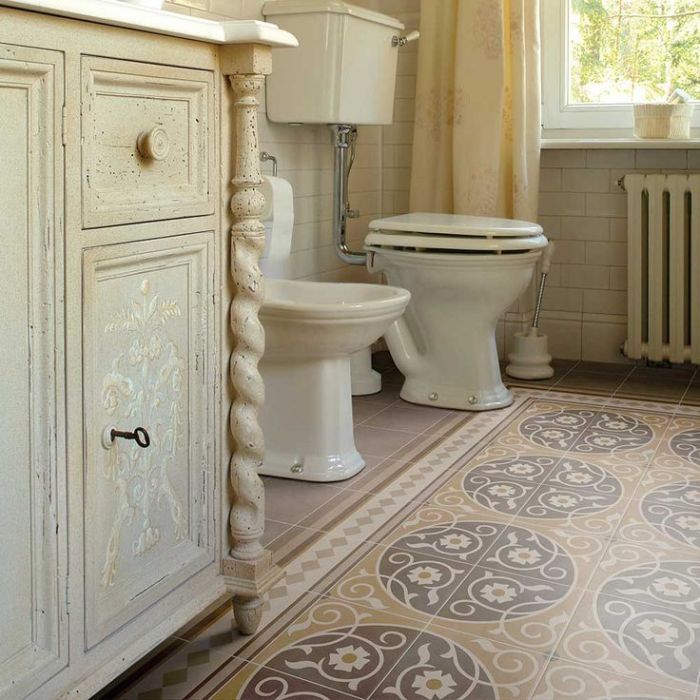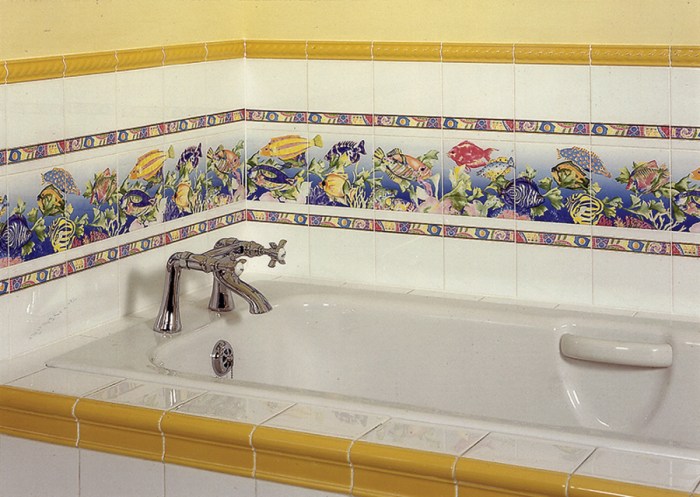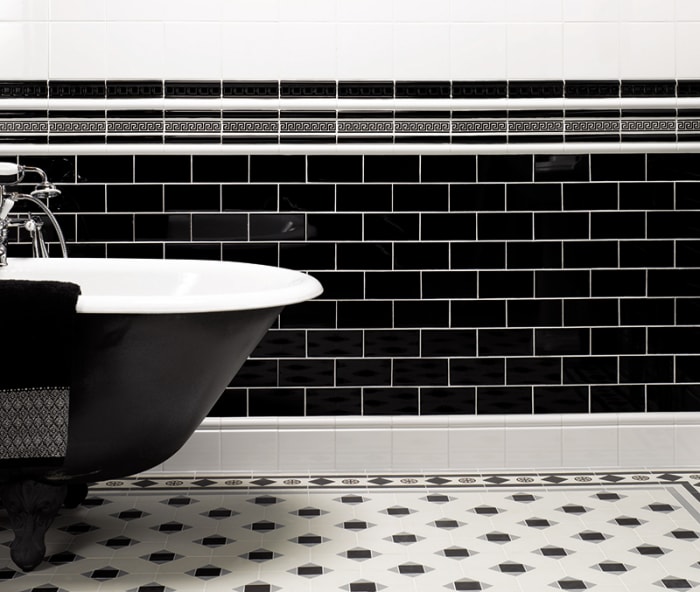Step into the enchanting world of historical reproduction tiles, where the allure of bygone eras meets the functionality of modern bathrooms. These tiles, meticulously crafted to replicate the designs and materials of the past, offer a captivating journey through time, transforming your bathroom into a sanctuary steeped in history and timeless beauty.
From the intricate patterns of encaustic tiles to the elegant simplicity of porcelain, historical reproduction tiles provide an unparalleled opportunity to recreate the grandeur and charm of period bathrooms. They serve as a testament to the artistry and craftsmanship of the past, while seamlessly blending with the conveniences of contemporary living.
Historical Accuracy and Authenticity
Using historically accurate reproduction tiles in period bathrooms is paramount for maintaining the aesthetic integrity and authenticity of the space. These tiles contribute to the overall ambiance, evoking the era and style they represent.Reproduction tiles offer a range of benefits, including:
- Preserving the historical character of the bathroom
- Enhancing the overall visual appeal and authenticity
- Providing a durable and long-lasting solution that complements the period-specific design
Sourcing historically accurate reproduction tiles can be challenging, requiring careful consideration of:
Availability
Ensure that the tiles are readily available or can be custom-made to match the original design.
Quality
Verify the quality of the tiles, ensuring they meet industry standards and are suitable for bathroom use.
Authenticity
Research the tiles’ historical accuracy, including their design, materials, and manufacturing techniques.
Types of Historical Reproduction Tiles
Historical reproduction tiles offer a diverse range of options for creating authentic period bathrooms. These tiles replicate the aesthetic and technical qualities of original historical tiles, allowing homeowners to restore or create bathrooms that evoke specific eras and architectural styles.
The primary types of historical reproduction tiles include encaustic, ceramic, and porcelain tiles. Each type possesses unique characteristics, advantages, and disadvantages, making them suitable for different historical periods and design preferences.
Encaustic Tiles
Encaustic tiles are a type of ceramic tile that is distinguished by its inlaid colored patterns. These patterns are created by pressing colored clay into a base tile, creating a durable and decorative surface. Encaustic tiles are known for their intricate designs and vibrant colors, making them a popular choice for Victorian and Edwardian bathrooms.
Advantages:
- Durable and long-lasting
- Intricate and eye-catching designs
- Authentic to Victorian and Edwardian periods
Disadvantages:
- More expensive than other types of tiles
- Can be difficult to clean and maintain
- Not suitable for areas with heavy foot traffic
Ceramic Tiles
Ceramic tiles are a versatile and affordable option for historical reproduction bathrooms. They are made from a mixture of clay and other materials, and are fired at high temperatures to create a durable and water-resistant surface. Ceramic tiles are available in a wide range of colors, shapes, and sizes, making them suitable for a variety of historical periods and design styles.
Advantages:
- Affordable and widely available
- Durable and easy to clean
- Available in a wide range of colors, shapes, and sizes
Disadvantages:
- Not as durable as encaustic or porcelain tiles
- Can be susceptible to chipping and cracking
- May not be suitable for areas with heavy foot traffic
Porcelain Tiles
Porcelain tiles are a type of ceramic tile that is made from a finer clay and fired at a higher temperature than regular ceramic tiles. This results in a more durable and water-resistant surface that is less likely to chip or crack.
Porcelain tiles are available in a wide range of colors, shapes, and sizes, making them suitable for a variety of historical periods and design styles.
Advantages:
- Durable and water-resistant
- Less likely to chip or crack
- Available in a wide range of colors, shapes, and sizes
Disadvantages:
- More expensive than other types of tiles
- Can be difficult to cut and install
- May not be suitable for areas with heavy foot traffic
Design Considerations for Period Bathrooms
When designing a period bathroom with historical reproduction tiles, several key considerations come into play to ensure authenticity and a harmonious aesthetic. These include:
Tile Size and Shape
The size and shape of the tiles can significantly impact the overall look of the bathroom. Smaller tiles, such as 2″ x 2″ or 4″ x 4″, create a more intricate and detailed look, while larger tiles, like 6″ x 6″ or 8″ x 8″, offer a more modern and streamlined appearance.
The shape of the tiles can also vary, with square, rectangular, and hexagonal tiles being common choices.
Color and Pattern
The color and pattern of the tiles are crucial for creating the desired ambiance. Neutral colors like white, cream, or gray can provide a timeless and elegant backdrop, while bolder colors like blue, green, or pink can add a touch of vibrancy.
Patterns can range from simple geometric designs to elaborate floral or Art Deco motifs.
Complementing the Overall Design Scheme
The tiles should complement the overall design scheme of the bathroom. For instance, a Victorian-style bathroom may feature tiles with intricate patterns and rich colors, while an Art Deco bathroom might use tiles with geometric designs and metallic accents. By carefully considering the size, shape, color, and pattern of the tiles, you can create a period bathroom that is both historically accurate and visually appealing.
Installation and Maintenance
Proper installation and maintenance are crucial for ensuring the beauty and longevity of historical reproduction tiles in period bathrooms. Meticulous preparation, precise grouting, and effective sealing are essential for a successful installation.
Before beginning, ensure the subfloor is level and free of debris. Use a high-quality thin-set mortar specifically designed for ceramic tiles. Apply the thin-set mortar evenly to the subfloor, using a notched trowel to create a uniform layer.
Grouting
Grouting plays a vital role in protecting the tiles from moisture and dirt. Use a grout that matches the color and style of the tiles. Apply the grout to the joints between the tiles, using a grout float or sponge.
Ensure the grout is pressed firmly into the joints, removing any excess.
Sealing
Sealing the tiles helps prevent stains and moisture penetration. Apply a high-quality penetrating sealer to the tiles and grout, following the manufacturer’s instructions. Allow the sealer to dry completely before using the bathroom.
Maintenance
Regular cleaning is essential for maintaining the beauty of historical reproduction tiles. Use a mild, non-abrasive cleaner and a soft cloth to gently wipe down the tiles. Avoid using harsh chemicals or abrasive cleaners, as these can damage the tiles.
Sources and Suppliers
When sourcing historical reproduction tiles for period bathrooms, it is essential to identify reputable suppliers who prioritize quality, authenticity, and customer service. Consider factors such as the supplier’s experience, craftsmanship, and reputation among industry professionals.
Trusted Manufacturers and Distributors
Numerous manufacturers and distributors specialize in crafting historical reproduction tiles with meticulous attention to detail. Some trusted names include:
- Original Style Tiles: Renowned for their extensive collection of Victorian and Edwardian tiles, ensuring authenticity and durability.
- Fireclay Tile: Offers a wide range of handmade tiles, including historical reproductions that capture the essence of bygone eras.
- Walker Zanger: Provides a curated selection of historical reproduction tiles, combining classic designs with modern manufacturing techniques.
- Ann Sacks: Specializes in sourcing and distributing high-quality tiles, including historical reproductions that meet the demands of period bathrooms.
Case Studies and Examples
Historical reproduction tiles can transform a modern bathroom into a timeless masterpiece. Here are inspiring examples showcasing their transformative impact:
1920s Art Deco Bathroom
This bathroom renovation used black and white hexagonal tiles on the floor and white subway tiles with a black border on the walls. The tiles were laid in a classic Art Deco pattern, creating a bold and geometric look. The result is a bathroom that captures the glamour and sophistication of the Roaring Twenties.
Victorian Farmhouse Bathroom
In this charming Victorian farmhouse, the homeowners opted for white and blue penny tiles on the floor and white wainscoting on the walls. The tiles were arranged in a diamond pattern, adding a touch of elegance to the space. The bathroom also features a clawfoot tub and vintage fixtures, completing the Victorian aesthetic.
Mid-Century Modern Bathroom
For a mid-century modern bathroom, square tiles in a neutral gray shade were used on the floor and walls. The tiles were laid in a simple grid pattern, creating a clean and minimalist look. The bathroom also features a floating vanity and a large mirror, giving it a spacious and airy feel.
Last Point
Incorporating historical reproduction tiles into your period bathroom is not merely a design choice but a celebration of architectural heritage. These tiles breathe life into the past, evoking the ambiance of stately manor houses, opulent Victorian bathrooms, and Art Deco powder rooms.
With careful consideration and meticulous installation, you can create a space that transports you to another era, where history and modernity harmoniously coexist.



